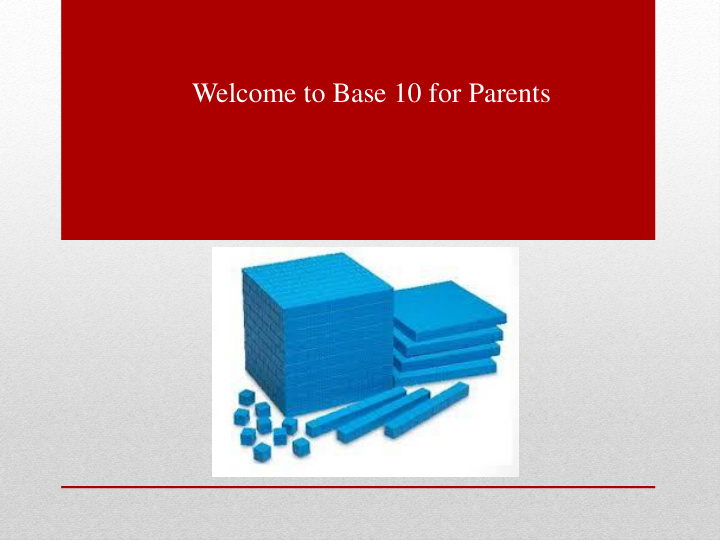



Welcome to Base 10 for Parents
Multiplication Write the times down Write the times across Fill out the array Count the amount
Multiplication Progression document Stage 3 Children continue to use arrays and create their own to represent multiplication calculations Stage 4 Children split the array up to lead into grid method
Multiplication Examples • Write the times/multiplier down • Write the times/Multiplier across • Fill out the array • Count out the amount Now it’s your turn!
Division 12÷4 = Division as grouping 24÷6= • Count the divider down • Count out the amount • Circle the Groups • Record the amount http://www.topmarks.co.uk/Flash.aspx?f=group ing
Division Progression document Children continue to use practical equipment to represent division calculations as grouping (repeated subtraction) and use jottings to support their calculation. 12 ÷ 3 = ? Children begin to read this calculation as, ‘How many groups of 3 are there in 12? At this stage, children will also be introduced to division calculations that result in remainders. 13 ÷ 4 = 3 remainder 1
Division with Remainders 18÷4 = Division as grouping • Count the divider down • Count out the amount • Circle the Groups • Are there any remainders? • Record the amount Now it’s your turn!
Addition 28+44= + Add the units/ones Carry the ten Add the tens
Addition Add the units/ones Circle what is left Carry the ten Add the tens +
Addition The units = less than ten = No need to circle what is left The units = more than ten = circle what is left after 10 and add an extra 10 The units = ten exactly = 0 units in the answer and add an extra 10. Success Criteria Add the units/ones Circle what is left Carry the ten Add the tens
Addition Progression document Children continue to use the Base 10 equipment to support their calculations, including exchanging 10 units/ones for 1 ten when the total of the units/ones is 10 or more. They will record their own drawings of the Base 10 equipment, using lines for 10 rods and dots for the unit blocks. 34 + 23 = ? The units/ones are added first 4 + 3 = 7 The tens are added next 30 + 20 = 50 Both answers are put together 50 + 7 = 57
Addition Continued progression document 28+36 The units/ones are added first 8 + 6 = 14 with ten units/ones exchanged for 1 ten. A ring is put around the units/ones not exchanged – this is the units part of the answer. The tens are then added, including the exchanged ten, to complete the sum.
Subtraction 37-19 Stage 2 Stage 3 Stage 1 Take away the units/ones (Exchange the ten) Continue take away Take away the tens
Subtraction Progression document Children continue to use the Base 10 equipment to support their calculations. They will record their own drawings of the Base 10 equipment, using lines for 10 rods and dots for the unit blocks. 39 - 17 = ? 39 is drawn 17 is crossed out A ring is drawn around what is left to give the answer giving 22
Subtraction Continued progression document 37 – 19 = ? 37 is drawn 9 units cannot be crossed out, so a ten is crossed out and exchanged for 10 ones which are in a line. e is written next to the exchanged ten. 19 is crossed out A ring is drawn around what is left to give the answer 18
Subtraction 33-15 Take away the units/ones (Exchange the ten) Continue take away Take away the tens
Any questions?
Recommend
More recommend